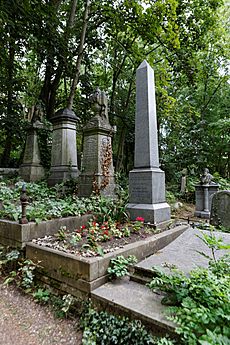George Eliot facts for kids
Quick facts for kids
George Eliot
|
|
|---|---|
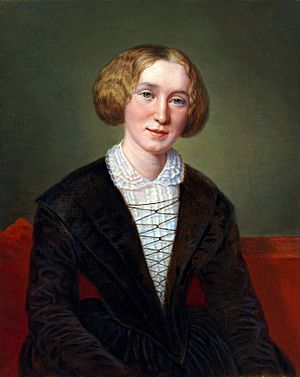
Eliot (Mary Ann Evans) in 1850
|
|
| Born | Mary Anne Evans 22 November 1819 Nuneaton, Warwickshire, England |
| Died | 22 December 1880 (aged 61) Chelsea, London, England |
| Resting place | Highgate Cemetery (East), Highgate, London |
| Pen name | George Eliot |
| Occupation | Novelist, poet, journalist, translator |
| Period | Victorian |
| Notable works | Scenes of Clerical Life (1858) Adam Bede (1859) The Mill on the Floss (1860) Silas Marner (1861) Romola (1862–1863) Felix Holt, the Radical (1866) Middlemarch (1871–72) Daniel Deronda (1876) |
| Spouse |
John Cross
(m. 1880) |
| Partner | George Henry Lewes (1854–1878) |
Mary Ann Evans (22 November 1819 – 22 December 1880; alternatively Mary Anne or Marian), known by her pen name George Eliot, was an English novelist, poet, journalist, translator, and one of the leading writers of the Victorian era. She wrote seven novels: Adam Bede (1859), The Mill on the Floss (1860), Silas Marner (1861), Romola (1862–63), Felix Holt, the Radical (1866), Middlemarch (1871–72) and Daniel Deronda (1876). Like Charles Dickens and Thomas Hardy, she emerged from provincial England; most of her works are set there. Her works are known for their realism, psychological insight, sense of place and detailed depiction of the countryside.
Middlemarch was described by the novelist Virginia Woolf as "one of the few English novels written for grown-up people" and by Martin Amis and Julian Barnes as the greatest novel in the English language.
Contents
Life
Early life and education
Mary Ann Evans was born in Nuneaton, Warwickshire, England. She was the third child of Robert Evans (1773–1849) and Christiana Evans (née Pearson, 1788–1836), the daughter of a local mill-owner. She spelled her name differently at different times: Mary Anne was the spelling used by her father for the baptismal record and she uses this spelling in her earliest letters. Within her family, however, it was spelled Mary Ann. By 1852, she had changed to Marian, but she reverted to Mary Ann in 1880 after she married John Cross. Mary Ann Cross (George Eliot) appears on her memorial stone.
Her full siblings were Christiana, known as Chrissey (1814–59), Isaac (1816–1890), and twin brothers who died a few days after birth in March 1821. She also had a half-brother, Robert Evans (1802–64), and half-sister, Frances "Fanny" Evans Houghton (1805–82), from her father's previous marriage to Harriet Poynton (1780-1809). Her father Robert Evans, of Welsh ancestry, was the manager of the Arbury Hall Estate for the Newdigate family in Warwickshire, and Mary Ann was born on the estate at South Farm. In early 1820 the family moved to a house named Griff House, between Nuneaton and Bedworth.
The young Evans was a voracious reader and obviously intelligent. Because she was not considered physically beautiful, Evans was not thought to have much chance of marriage, and this, coupled with her intelligence, led her father to invest in an education not often afforded women. From ages five to nine, she boarded with her sister Chrissey at Miss Latham's school in Attleborough, from ages nine to thirteen at Mrs. Wallington's school in Nuneaton, and from ages 13 to 16 at Miss Franklin's school in Coventry. At Mrs. Wallington's school, she was taught by the evangelical Maria Lewis—to whom her earliest surviving letters are addressed. In the religious atmosphere of the Misses Franklin's school, Evans was exposed to a quiet, disciplined belief opposed to evangelicalism.
After age sixteen, Evans had little formal education. Thanks to her father's important role on the estate, she was allowed access to the library of Arbury Hall, which greatly aided her self-education and breadth of learning. Her classical education left its mark; Christopher Stray has observed that "George Eliot's novels draw heavily on Greek literature (only one of her books can be printed correctly without the use of a Greek typeface), and her themes are often influenced by Greek tragedy". Her frequent visits to the estate also allowed her to contrast the wealth in which the local landowner lived with the lives of the often much poorer people on the estate, and different lives lived in parallel would reappear in many of her works. The other important early influence in her life was religion. She was brought up within a low church Anglican family, but at that time the Midlands was an area with a growing number of religious dissenters.
Move to Coventry
In 1836 her mother died and Evans (then 16) returned home to act as housekeeper, but she continued correspondence with her tutor Maria Lewis. When she was 21, her brother Isaac married and took over the family home, so Evans and her father moved to Foleshill near Coventry. The closeness to Coventry society brought new influences, most notably those of Charles and Cara Bray. Charles Bray had become rich as a ribbon manufacturer and had used his wealth in the building of schools and in other philanthropic causes. Evans, who had been struggling with religious doubts for some time, became intimate friends with the radical, free-thinking Brays, whose "Rosehill" home was a haven for people who held and debated radical views. The people whom the young woman met at the Brays' house included Robert Owen, Herbert Spencer, Harriet Martineau, and Ralph Waldo Emerson. Through this society Evans was introduced to more liberal and agnostic theologies and to writers such as David Strauss and Ludwig Feuerbach, who cast doubt on the literal truth of Biblical texts. In fact, her first major literary work was an English translation of Strauss's Das Leben Jesu kritisch bearbeitet as The Life of Jesus, Critically Examined (1846), which she completed after it had been left incomplete by Elizabeth "Rufa" Brabant, another member of the "Rosehill Circle".
The Strauss book had caused a sensation in Germany by arguing that the miracles in the New Testament were mythical additions with little basis in fact. Evans's translation had a similar effect in England, the Earl of Shaftesbury calling her translation "the most pestilential book ever vomited out of the jaws of hell." Later she translated Feuerbach's The Essence of Christianity (1854). The ideas in these books would have an effect on her own fiction, as detailed below.
As a product of their friendship, Bray published some of Evans's own earliest writing, such as reviews, in his newspaper the Coventry Herald and Observer. As Evans began to question her own religious faith, her father threatened to throw her out of the house, but his threat was not carried out. Instead, she respectfully attended church and continued to keep house for him until his death in 1849, when she was 30. Five days after her father's funeral, she travelled to Switzerland with the Brays. She decided to stay on in Geneva alone, living first on the lake at Plongeon (near the present-day United Nations buildings) and then on the second floor of a house owned by her friends François and Juliet d'Albert Durade on the rue de Chanoines (now the rue de la Pelisserie). She commented happily that "one feels in a downy nest high up in a good old tree". Her stay is commemorated by a plaque on the building. While residing there, she read avidly and took long walks in the beautiful Swiss countryside, which was a great inspiration to her. François Durade painted her portrait there as well.
Move to London and editorship of the Westminster Review
On her return to England the following year (1850), she moved to London with the intent of becoming a writer, and she began referring to herself as Marian Evans. She stayed at the house of John Chapman, the radical publisher whom she had met earlier at Rosehill and who had published her Strauss translation. Chapman had recently purchased the campaigning, left-wing journal The Westminster Review. Evans became its assistant editor in 1851 after joining just a year earlier. Evans's writings for the paper were comments on her views of society and the Victorian way of thinking. She was sympathetic to the lower classes and criticised organised religion throughout her articles and reviews and commented on contemporary ideas of the time. Much of this was drawn from her own experiences and knowledge and she used this to critique other ideas and organisations. This led to her writing being viewed as authentic and wise but not too obviously opinionated. Evans also focused on the business side of the Review with attempts to change its layout and design. Although Chapman was officially the editor, it was Evans who did most of the work of producing the journal, contributing many essays and reviews beginning with the January 1852 issue and continuing until the end of her employment at the Review in the first half of 1854. Eliot sympathized with the 1848 Revolutions throughout continental Europe, and even hoped that the Italians would chase the "odious Austrians" out of Lombardy and that "decayed monarchs" would be pensioned off, although she believed a gradual reformist approach to social problems was best for England.
In 1850–51, Evans attended classes in mathematics at the Ladies College in Bedford Square, later known as Bedford College, London.
Relationship with George Lewes
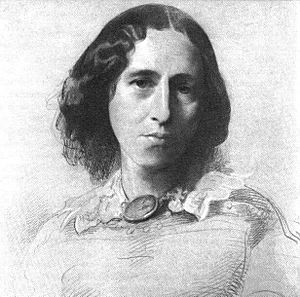
The philosopher and critic George Henry Lewes (1817–78) met Evans in 1851, and by 1854 they had decided to live together. Lewes was already married to Agnes Jervis, although in an open marriage. In addition to the three children they had together, Agnes also had four children by Thornton Leigh Hunt. In July 1854, Lewes and Evans travelled to Weimar and Berlin together for the purpose of research. Before going to Germany, Evans continued her theological work with a translation of Feuerbach's The Essence of Christianity, and while abroad she wrote essays and worked on her translation of Baruch Spinoza's Ethics, which she completed in 1856, but which was not published in her lifetime. In 1981, Eliot's translation of Spinoza's Ethics was finally published by Thomas Deegan, and was determined to be in the public domain in 2018 and published by the George Eliot Archive. It has been re-published in 2020 by Princeton University Press.
The trip to Germany also served as a honeymoon for Evans and Lewes, who subsequently considered themselves married. Evans began to refer to Lewes as her husband and to sign her name as Mary Ann Evans Lewes, legally changing her name to Mary Ann Evans Lewes after his death. The refusal to conceal the relationship was contrary to the social conventions of the time, and attracted considerable disapproval.
Career in fiction
While continuing to contribute pieces to the Westminster Review, Evans resolved to become a novelist, and set out a pertinent manifesto in one of her last essays for the Review, "Silly Novels by Lady Novelists" (1856). The essay criticised the trivial and ridiculous plots of contemporary fiction written by women. In other essays, she praised the realism of novels that were being written in Europe at the time, an emphasis on realistic storytelling confirmed in her own subsequent fiction. She also adopted a nom-de-plume, George Eliot; as she explained to her biographer J. W. Cross, George was Lewes's forename, and Eliot was "a good mouth-filling, easily pronounced word". Although female authors were published under their own names during her lifetime, she wanted to escape the stereotype of women's writing being limited to lighthearted romances or other lighter fare not to be taken very seriously. She also wanted to have her fiction judged separately from her already extensive and widely known work as a translator, editor, and critic. Another factor in her use of a pen name may have been a desire to shield her private life from public scrutiny, thus avoiding the scandal that would have arisen because of her relationship with the married George Henry Lewes.
In 1857, when she was 37 years of age, "The Sad Fortunes of the Reverend Amos Barton", the first of the three stories included in Scenes of Clerical Life, and the first work of "George Eliot", was published in Blackwood's Magazine. The Scenes (published as a 2-volume book in 1858), was well received, and was widely believed to have been written by a country parson, or perhaps the wife of a parson.
Eliot was profoundly influenced by the works of Thomas Carlyle. As early as 1841, she referred to him as "a grand favourite of mine", and references to him abound in her letters from the 1840s and 1850s. According to University of Victoria professor Lisa Surridge, Carlyle "stimulated Eliot's interest in German thought, encouraged her turn from Christian orthodoxy, and shaped her ideas on work, duty, sympathy, and the evolution of the self." These themes made their way into Evans's first complete novel, Adam Bede (1859). It was an instant success, and prompted yet more intense curiosity as to the author's identity: there was even a pretender to the authorship, one Joseph Liggins. This public interest subsequently led to Marian Evans Lewes's acknowledgment that it was she who stood behind the pseudonym George Eliot. Adam Bede is known for embracing a realist aesthetic inspired by Dutch visual art.
The revelations about Eliot's private life surprised and shocked many of her admiring readers, but this did not affect her popularity as a novelist. Her relationship with Lewes afforded her the encouragement and stability she needed to write fiction, but it would be some time before the couple were accepted into polite society. Acceptance was finally confirmed in 1877 when they were introduced to Princess Louise, the daughter of Queen Victoria. The queen herself was an avid reader of all of Eliot's novels and was so impressed with Adam Bede that she commissioned the artist Edward Henry Corbould to paint scenes from the book.
When the American Civil War broke out in 1861, Eliot expressed sympathy for the Union cause, something which historians have attributed to her abolitionist sympathies. In 1868, she supported philosopher Richard Congreve's protests against governmental policies in Ireland and had a positive view of the growing movement in support of Irish home rule.
She was influenced by the writings of John Stuart Mill and read all of his major works as they were published. In Mill's Subjection of Women (1869) she judged the second chapter excoriating the laws which oppress married women "excellent." She was supportive of Mill's parliamentary run, but believed that the electorate was unlikely to vote for a philosopher and was surprised when he won. While Mill served in parliament, she expressed her agreement with his efforts on behalf of female suffrage, being "inclined to hope for much good from the serious presentation of women's claims before Parliament." In a letter to John Morley, she declared her support for plans "which held out reasonable promise of tending to establish as far as possible an equivalence of advantage for the two sexes, as to education and the possibilities of free development", and dismissed appeals to nature in explaining women's lower status. In 1870, she responded enthusiastically to Lady Amberley's feminist lecture on the claims of women for education, occupations, equality in marriage, and child custody.
After the success of Adam Bede, Eliot continued to write popular novels for the next fifteen years. Within a year of completing Adam Bede, she finished The Mill on the Floss, dedicating the manuscript: "To my beloved husband, George Henry Lewes, I give this MS. of my third book, written in the sixth year of our life together, at Holly Lodge, South Field, Wandsworth, and finished 21 March 1860." Silas Marner (1861) and Romola (1863) soon followed, and later Felix Holt, the Radical (1866) and her most acclaimed novel, Middlemarch (1871–1872).
Her last novel was Daniel Deronda, published in 1876, after which she and Lewes moved to Witley, Surrey. By this time Lewes's health was failing, and he died two years later, on 30 November 1878. Eliot spent the next two years editing Lewes's final work, Life and Mind, for publication, and found solace and companionship with John Walter Cross, a Scottish commission agent 20 years her junior, whose mother had recently died.
Marriage to John Cross and death
On 16 May 1880 Eliot married John Walter Cross (1840–1924) and again changed her name, this time to Mary Ann Cross. While the marriage courted some controversy due to the difference in ages, it pleased her brother Isaac, who had broken off relations with her when she had begun to live with Lewes, and now sent congratulations. The newlyweds returned to England. They moved to a new house in Chelsea, but Eliot fell ill with a throat infection. This, coupled with the kidney disease with which she had been afflicted for several years, led to her death on 22 December 1880 at the age of 61.
Due to her denial of the Christian faith and her relationship with Lewes, Eliot was not buried in Westminster Abbey. She was instead interred in Highgate Cemetery (East), Highgate, London, in the area reserved for political and religious dissenters and agnostics, beside the love of her life, George Henry Lewes. The graves of Karl Marx and her friend Herbert Spencer are nearby. In 1980, on the centenary of her death, a memorial stone was established for her in the Poets' Corner.
Several landmarks in her birthplace of Nuneaton are named in her honour. These include The George Eliot Academy, Middlemarch Junior School, George Eliot Hospital (formerly Nuneaton Emergency Hospital), and George Eliot Road, in Foleshill, Coventry.
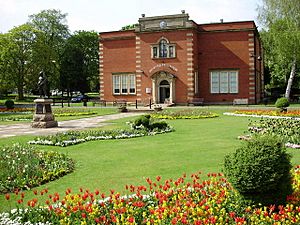
A statue of Eliot is in Newdegate Street, Nuneaton, and Nuneaton Museum & Art Gallery has a display of artifacts related to her.
Literary assessment
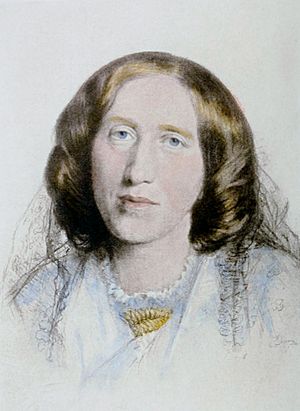
Throughout her career, Eliot wrote with a politically astute pen. From Adam Bede to The Mill on the Floss and Silas Marner, Eliot presented the cases of social outsiders and small-town persecution. Felix Holt, the Radical and The Legend of Jubal were overtly political, and political crisis is at the heart of Middlemarch, in which she presents the stories of a number of inhabitants of a small English town on the eve of the Reform Bill of 1832; the novel is notable for its deep psychological insight and sophisticated character portraits. The roots of her realist philosophy can be found in her review of John Ruskin's Modern Painters in Westminster Review in 1856.
Readers in the Victorian era praised her novels for their depictions of rural society. Much of the material for her prose was drawn from her own experience. She shared with Wordsworth the belief that there was much value and beauty to be found in the mundane details of ordinary country life. Eliot did not, however, confine herself to stories of the English countryside. Romola, an historical novel set in late fifteenth century Florence, was based on the life of the Italian priest Girolamo Savonarola. In The Spanish Gypsy, Eliot made a foray into verse, but her poetry's initial popularity has not endured.
Working as a translator, Eliot was exposed to German texts of religious, social, and moral philosophy such as Friedrich Strauss’s Life of Jesus, Feuerbach’s The Essence of Christianity, and Spinoza’s Ethics. Elements from these works show up in her fiction, much of which is written with her trademark sense of agnostic humanism. She had taken particular notice of Feuerbach’s conception of Christianity, positing that our understanding of the nature of the divine was to be found ultimately in the nature of humanity projected onto a divine figure. An example of this philosophy appeared in her novel Romola, in which Eliot’s protagonist displayed a "surprisingly modern readiness to interpret religious language in humanist or secular ethical terms." Though Eliot herself was not religious, she had respect for religious tradition and its ability to maintain a sense of social order and morality. The religious elements in her fiction also owe much to her upbringing, with the experiences of Maggie Tulliver from The Mill on the Floss sharing many similarities with the young Mary Ann Evans. Eliot also faced a quandary similar to that of Silas Marner, whose alienation from the church simultaneously meant his alienation from society. Because Eliot retained a vestigial respect for religion, German philosopher Friedrich Nietzsche excoriated her system of morality for figuring sin as a debt that can be expiated through suffering, which he demeaned as characteristic of "little moralistic females à la Eliot."
She was at her most autobiographical in Looking Backwards, part of her final published work Impressions of Theophrastus Such. By the time of Daniel Deronda, Eliot's sales were falling off, and she had faded from public view to some degree. This was not helped by the posthumous biography written by her husband, which portrayed a wonderful, almost saintly, woman totally at odds with the scandalous life people knew she had led. In the 20th century she was championed by a new breed of critics, most notably by Virginia Woolf, who called Middlemarch "one of the few English novels written for grown-up people". In 1994, literary critic Harold Bloom placed Eliot among the most important Western writers of all time. In a 2007 authors' poll by Time, Middlemarch was voted the tenth greatest literary work ever written. In 2015, writers from outside the UK voted it first among all British novels "by a landslide". The various film and television adaptations of Eliot's books have re-introduced her to the wider reading public.
Works
Novels
- Adam Bede, 1859
- The Mill on the Floss, 1860
- Silas Marner, 1861
- Romola, 1863
- Felix Holt, the Radical, 1866
- Middlemarch, 1871–72
- "Quarry for Middlemarch", MS Lowell 13, Houghton Library, Harvard University (A digital facsimile of the manuscript)
- Daniel Deronda, 1876
Short story collection and novellas
- Scenes of Clerical Life, 1857
- The Sad Fortunes of the Rev. Amos Barton
- Mr Gilfil's Love Story
- Janet's Repentance
- The Lifted Veil, 1859
- Brother Jacob, 1864
- Impressions of Theophrastus Such, 1879
Translations
- Das Leben Jesu, kritisch bearbeitet (The Life of Jesus, Critically Examined) Volume 2 by David Strauss, 1846
- Das Wesen des Christentums (The Essence of Christianity) by Ludwig Feuerbach, 1854
- The Ethics of Benedict de Spinoza by Benedict de Spinoza, 1856
Poetry
- Knowing That I Must Shortly Put Off This Tabernacle, 1840
- In a London Drawingroom, 1865
- A Minor Prophet, 1865
- A Minor Prophet free PDF of Blackwood's 1878 Cabinet Edition (the critical standard with Eliot's final corrections) at the George Eliot Archive
- Two Lovers, 1866
- Two Lovers free PDF of Blackwood's 1878 Cabinet Edition (the critical standard with Eliot's final corrections) at the George Eliot Archive
- The Choir Invisible, 1867
- The Choir Invisible free PDF of Blackwood's 1878 Cabinet Edition (the critical standard with Eliot's final corrections) at the George Eliot Archive
- The Spanish Gypsy, 1868
- The Spanish Gypsy free PDF of Blackwood's 1878 Cabinet Edition (the critical standard with Eliot's final corrections) at the George Eliot Archive
- Agatha, 1868
- Agatha free PDF of Blackwood's 1878 Cabinet Edition (the critical standard with Eliot's final corrections) at the George Eliot Archive
- Brother and Sister, 1869
- The Brother and Sister free PDF of Blackwood's 1878 Cabinet Edition (the critical standard with Eliot's final corrections) at the George Eliot Archive
- How Lisa Loved the King, 1869
- How Lisa Loved the King free PDF of Blackwood's 1878 Cabinet Edition (the critical standard with Eliot's final corrections) at the George Eliot Archive
- Armgart, 1870
- Armgart free PDF of Blackwood's 1878 Cabinet Edition (the critical standard with Eliot's final corrections) at the George Eliot Archive
- Stradivarius, 1873
- Stradivarius free PDF of Blackwood's 1878 Cabinet Edition (the critical standard with Eliot's final corrections) at the George Eliot Archive
- Arion, 1873
- Arion free PDF of Blackwood's 1878 Cabinet Edition (the critical standard with Eliot's final corrections) at the George Eliot Archive
- The Legend of Jubal, 1874
- The Legend of Jubal free PDF of Blackwood's 1878 Cabinet Edition (the critical standard with Eliot's final corrections) at the George Eliot Archive
- I Grant You Ample Leave, 1874
- Evenings Come and Go, Love, 1878
- Evenings Come and Go, Love free PDF of Blackwood's 1878 Cabinet Edition (the critical standard with Eliot's final corrections) at the George Eliot Archive
- Self and Life, 1879
- Self and Life free PDF of Blackwood's 1878 Cabinet Edition (the critical standard with Eliot's final corrections) at the George Eliot Archive
- A College Breakfast Party, 1879
- A College Breakfast Party free PDF of Blackwood's 1878 Cabinet Edition (the critical standard with Eliot's final corrections) at the George Eliot Archive
- The Death of Moses, 1879
- The Death of Moses free PDF of Blackwood's 1878 Cabinet Edition (the critical standard with Eliot's final corrections) at the George Eliot Archive
Non-fiction
- "Three Months in Weimar", 1855
- "Silly Novels by Lady Novelists", 1856
- "The Natural History of German Life", 1856
- Review of John Ruskin's Modern Painters in Westminster Review, April 1856
- "The Influence of Rationalism", 1865
See also
 In Spanish: George Eliot para niños
In Spanish: George Eliot para niños



